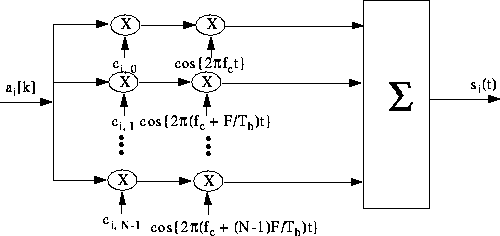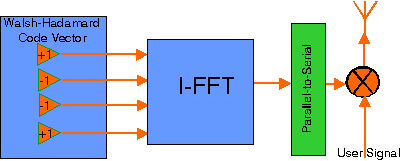| |
Multi-Carrier
CDMA (MC-CDMA) |
|
| 1993 |
Prof.
Jean-Paul Linnartz started
his research on Multi Carrier - Code Division Multiple Access (MC-CDMA)
in 1992 at the Department of Electrical
Engineering and Computer Sciences, University of California at Berkeley.
The research results were first presented to a wide public in 1993 at
the PIMRC Conference in Yokohama, Japan. Other researchers were also
working on similar schemes at the same time. Different names have been
proposed for the transmission method, e.g., OFDM - CDMA but our name
MC-CDMA is the most widely adopted.
|
|
| |
Currently,
the many papers on the topic of MC-CDMA are presented at every communication
conference. The original 1993 paper: (scanned pdf
of 2.8 mbytes, pdf)
|
|
BACKGROUND
The research on MC-CDMA intends to improve the reliability
and performance of wireless radio links. The mobile or indoor radio channel
is characterized by 'multipath reception': The signal offered to the receiver
contains not only a direct line-of-sight radio wave, but also a large number
of reflected radio waves. These reflected waves interfere with the direct wave,
which causes significant degradation of the performance of the network. A wireless
network has to be designed in such way that the adverse effect of these reflections
is minimized. Another critical design objective is high spectrum efficiency.
The latter should ensure that the network can accommodate as many users possible
within a given frequency band.
The effects of (multipath) radio propagation, modulation,
and coding and signal processing techniques on the spectrum efficiency and performance
of wireless radio networks are studied, in particular Orthogonal Frequency Division
Multiplexing (OFDM) and related transmission methods.
Most conventional modulation techniques are sensitive
to intersymbol interference unless the channel symbol rate is small compared
to the delay spread of the channel. OFDM is significantly less sensitive to
intersymbol interference, because a special set of signals is used to build
the composite transmitted signal. The basic idea is that each bit occupies a
frequency-time window which ensures little or no distortion of the waveform.
In practice it means that bits are transmitted in parallel over a number of
frequency nonselective channels. This technique is for instance used in digital
audio broadcasting (DAB).
- What is MC-CDMA?
- Learn more about OFDM
- What are the advantages of MC-CDMA?
- How can it be implemented?
- Some papers
WHAT IS ORTHOGONAL MULTI-CARRIER CDMA?
There are many equivalent
ways to describe MC-CDMA:
- MC-CDMA is a form of CDMA or spread spectrum, but
we apply the spreading in the frequency domain (rather than in the time domain
as in Direct Sequence CDMA).
- MC-CDMA is a form of Direct Sequence CDMA, but
after spreading, a Fourier Transform (FFT) is performed.
- MC-CDMA is a form of Orthogonal Frequency Division
Multiplexing (OFDM), but we first apply an orthogonal matrix operation to
the user bits. Therefor, MC-CDMA is sometimes also called "CDMA-OFDM".
- MC-CDMA is a form of Direct Sequence CDMA, but
our code sequence is the Fourier Transform of a Walsh Hadamard sequence.
- MC-CDMA is a form of frequency diversity. Each
bit is transmitted simultaneously (in parallel) on many different subcarriers.
Each subcarrier has a (constant) phase offset. The set of frequency offsets
form a code to distinguish different users.
P.S. Our MC-CDMA is NOT the same as DS-CDMA using
multiple carriers.
WHAT ARE THE ADVANTAGES OF MC-CDMA?
- Compared to Direct Sequence (DS) CDMA.
DS-CDMA is a method to share spectrum among multiple simultaneous users. Moreover,
it can exploit frequency diversity, using RAKE receivers. However, in a dispersive
multipath channel, DS-CDMA with a spread factor N can accommodate N simultaneous
users only if highly complex interference cancellation techniques are used.
In practice this is difficult to implement. MC-CDMA can handle N simultaneous
users with good BER, using standard receiver techniques.
- Compared to OFDM.
To avoid excessive bit errors on subcarriers that are in a deep fade, OFDM
typically applies coding. Hence, the number of subcarriers needed is larger
than the number of bits or symbols transmitted simultaneously. MC-CDMA replaces
this encoder by an NxN matrix operation. See: Derivation.
More advanced derivation including Doppler
MC-CDMA Transmitter

Figure: possible implementation of an Multi-Carrier spread-spectrum
transmitter. Each bit is transmitted over N different subcarriers.
Each subcarrier has its own phase offset, determined by the spreading code.
MC-Code Division Multiple Access systems allow simultaneous
transmission of several such user signals on the same set of subcarriers. In
the downlink multiplexer, this can be implemented using an Inverse FFT and a
Code Matrix.
 |
Figure:
FFT implementation of an MC-CDMA base station multiplexer and transmitter.
|
MC-CDMA as a special case of DS-CDMA
 |
Figure:
possible implementation of a Multi-Carrier spread-spectrum transmitter.
Each bit is transmitted over N different subcarriers. Each subcarrier
has its own phase offset, determined by the spreading code. Note that
the code is fixed over time, but only varies with subcarrier frequency!
|
The above transmitter can also be implemented as
a Direct-Sequence CDMA transmitter, i.e., one in which the user signal is multiplied
by a fast code sequence. However, the new code sequence is the Discrete Fourier
Transform of a binary, say, Walsh Hadamard code sequence, so it has complex
values.
 |
Figure:
Alternative implementation of a Multi-Carrier spread-spectrum transmitter,
using the Direct sequence principle.
|
SOME PUBLICATIONS
- N.Yee, J.P.M.G. Linnartz and G. Fettweis, Multi-Carrier-CDMA
in indoor wireless networks, Conference Proceedings PIMRC '93, Yokohama, Sept,
1993. p 109-113 (scanned paper pdf
of 2.8 mbytes Linnartz MC-CDMA PIMRC 1993)
-
This paper presented our first ideas
on MC-CDMA. It is the first paper on this form of modulation, and the first
to use the name MC-CDMA.
- N.Yee, J.P.M.G.
Linnartz and G. Fettweis, Multi-Carrier-CDMA in indoor wireless networks,
IEICE Transaction on Communications, Japan, Vol. E77-B, No. 7, July 1994,
pp. 900- 904.
- N. Yee and J.P.M.G. Linnartz, "Controlled equalization
for Multi-Carrier CDMA" VTC 1994, Stockholm, June 1994.PDF
An improved receiver method to MC-CDMA.
It addresses the question of how to weight different subcarriers with different
channel attenuation. On one hand, Maximum Ratio Combining is optimum against
noise, but gives poor performance if multiple MC-CDMA signals are present.
On the other hand, equalizing the amplitudes of all subcarriers in a downlink
restores the orthogonality, but excessively boosts the noise
- N. Yee and J.P.M.G. Linnartz, "Wiener filtering
for Multi-Carrier CDMA", IEEE / ICCC conference on Personal Indoor Mobile
Radio Communications (PIMRC) and Wireless Computer Networks
(WCN), The Hague, September 19-23, 1994, Vol. 4, pp. 1344-1347.
This paper finds optimum weight (MMSE)
factor for subcarriers. It shows that with a fairly straigtforward receiver
implementation, good BER can be achieved (10^-5 at 16 dB SNR),
even if N users are present in an MC-CDMA system with spread factor N. Performance
improves with increasing (!) channel dispersion and with increasing N.
- J.P.M.G. Linnartz and A. Gorokhov, "New equalization
approach for OFDM over dispersive and rapidly time varying channel.",
PIMRC ’00, London, Sept. 2000
- J.P.M.G. Linnartz, "Synchronous MC-CDMA in
dispersive, mobile Rayleigh channels", IEEE Benelux Signal Processing
Symposium, SPS200, Hilvarenbeek, March 23-24, 2000.
Studies the effect of Doppler on OFDM
and MC-CDMA.
- N. Yee and J.P.M.G. Linnartz, "Multi-Carrier in an indoor wireless radio channel",
Memorandum UCB/ERL M94/6, U.C. Berkeley, 1994.
[94-R1]
N. Yee and J.P.M.G. Linnartz, "Multi-Carrier in an indoor wireless radio channel",
Memorandum UCB/ERL M94/6, U.C. Berkeley, 1994. http://www.eecs.berkeley.edu/Pubs/TechRpts/1994/ERL-94-6.pdf (UCB bib data)
- N. Yee and J.P.M.G. Linnartz, "Multi-Carrier Mc-CDMA Receiver Code
Division Multiple Access (MC-CDMA): a new spreading technique for communication
over multipath channels", Final Report 93-101 (also 92-092), Microelectronics
Innovation and Computer Research Opportunities, University of California,
Oakland, CA 94612-3550.
- J.P.M.G. Linnartz, "Performance Analysis of Synchronous
MC-CDMA in mobile Rayleigh channels with both Delay and Doppler spreads",
IEEE Transactions on VT, Nov. 2001.PDF
- Wireless
Communication, The Interactive Multimedia CD ROM.
- An on-line tutorial
on OFDM and MC-CDMA (SMIL / Real-Audio).
- OFDM in mobile communications;
The effect of Doppler
- Profs. Linnartz and Hara are guest editors of a
special issue on Multi-Carrier Communications for "Wireless
Personal Communications" (Kluwer).
-
 300k
PDF [01-J2] PDF J.P.M.G.
Linnartz, "Performance Analysis of Synchronous MC-CDMA in mobile Rayleigh channels
with both Delay and Doppler spreads", IEEE VT, Vol. 50, No. 6, Nov. 2001, pp
1375-1387.
300k
PDF [01-J2] PDF J.P.M.G.
Linnartz, "Performance Analysis of Synchronous MC-CDMA in mobile Rayleigh channels
with both Delay and Doppler spreads", IEEE VT, Vol. 50, No. 6, Nov. 2001, pp
1375-1387.





 300k
PDF [01-J2] PDF J.P.M.G.
Linnartz, "Performance Analysis of Synchronous MC-CDMA in mobile Rayleigh channels
with both Delay and Doppler spreads", IEEE VT, Vol. 50, No. 6, Nov. 2001, pp
1375-1387.
300k
PDF [01-J2] PDF J.P.M.G.
Linnartz, "Performance Analysis of Synchronous MC-CDMA in mobile Rayleigh channels
with both Delay and Doppler spreads", IEEE VT, Vol. 50, No. 6, Nov. 2001, pp
1375-1387.